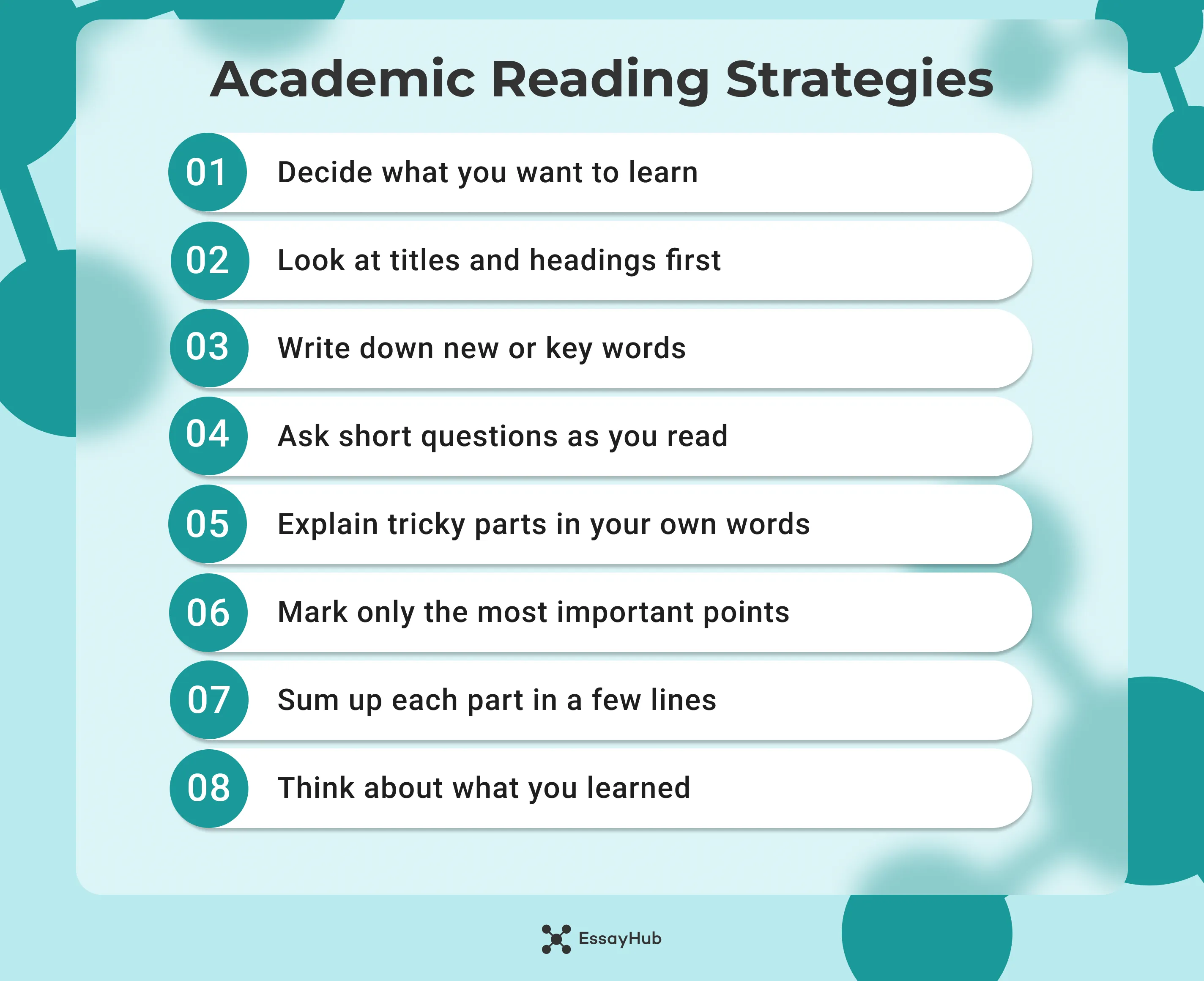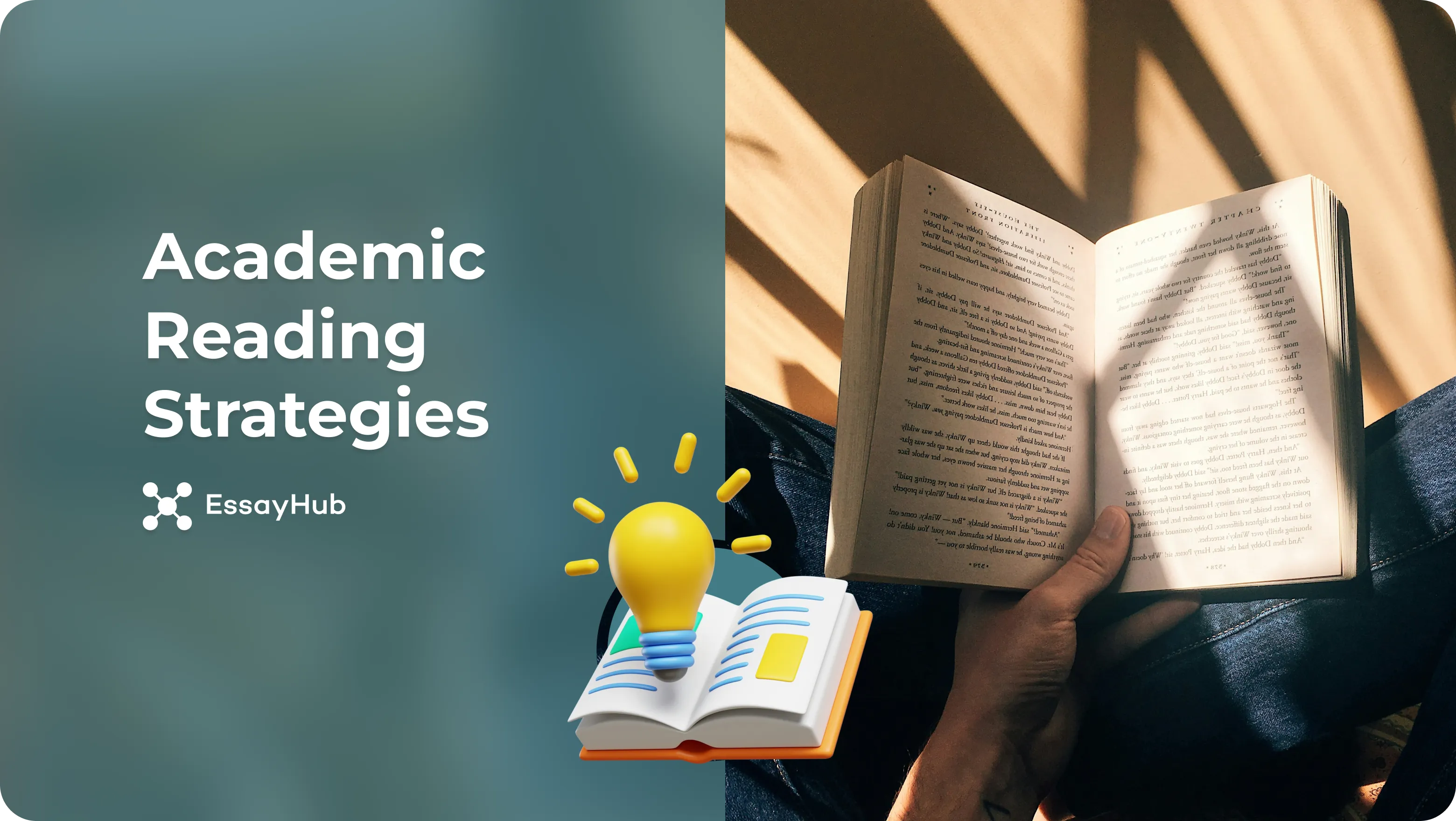Academic reading means studying a text with focus and intention. When you engage in active reading strategies, you examine each section for evidence and connection. The goal of this is to understand how different ideas work together. Academic reading techniques are different from casual reading because, instead of scanning, you identify patterns and test logic to learn how scholarly articles build arguments.
Meanwhile, if deadlines feel endless, remember EssayHub’s academic ghost writer can step in at moments like this to handle your dreaded assignments.
Academic Reading Purposes
Academic reading helps you understand new ideas and examine how knowledge is built. It turns the reading process into a thoughtful act instead of a routine task. You stop skimming through texts for quick answers and learn how to read with attention and actual purpose. Students use it to follow arguments, trace connections, and form opinions based on evidence. This type of reading also helps you identify relationships between different studies and recognize patterns in thinking. Each page reveals how research fits into a larger conversation. The main purpose is understanding with intention, not repetition.
Types of Academic Reading
There are several forms of academic reading, and each one serves a different goal.
- Analytical reading focuses on the structure of an argument. You look at how claims are made and what supports them.
- Critical reading examines the reasoning behind those claims. You notice the quality of the evidence and question its strength.
- Skimming helps you notice layout and general flow before reading deeply.
- Scanning guides you toward specific details or key words.
- Comparative reading places several texts side by side. It shows where authors agree and where they part ways.
Academic Reading Strategies That Strengthen Understanding
Reading works best when each stage has a purpose. Preparation gives you context. Active reading keeps your mind engaged. Reflection turns information into knowledge. Let’s go through each step of academic reading and the techniques you should be using to make the process more productive.

Techniques to Use Before Reading
Comprehension begins well before the first page. Try these simple techniques to prepare your mind for focusing:
- Set a goal. Think about what you want to learn from the text.
- Write guiding questions. Note a few things you hope the reading will answer.
- Preview the structure. Look at the headings, introduction, and summary to see how ideas are organized.
- Learn about the author. Find out their background and point of view.
- List new terms. Write down unfamiliar words before you start so they don’t break your focus later.
What To Do While You Read
Active reading turns the text into a conversation. Follow these strategies to keep your focus strong during reading:
- Highlight key ideas. Mark sentences that carry real weight and capture the main argument.
- Write short notes. Leave brief thoughts or reactions beside sections that stand out.
- Pause often. When a paragraph feels dense, stop for a moment. Try to restate it in clear, simple words before moving on.
- Keep a reading notebook. Record new vocabulary, short summaries, and definitions that deepen understanding.
- Look for patterns. Notice repetition, examples, or transitions that show how the argument takes shape.
- Stay engaged. Regular academic reading practice improves focus and makes comprehension feel more natural.
After You Finish Reading
Finishing a text is only part of the work. After you take a moment to look back and reflect, try these steps:
- Summarize the text. Write a short version in your own words that includes the main claim, supporting points, and conclusion.
- Check your purpose. Think about whether the reading answered the questions you started with.
- Save your notes. Keep your summaries and key insights where you can review them later.
- Evaluate the author. Ask if the reasoning felt balanced and if the sources seemed reliable.
- Talk it out. Discuss your thoughts with classmates or instructors to test your understanding.
- Reflect and apply. Use what you learned to strengthen future readings and class discussions.
Mistakes to Avoid During Academic Reading
Even thoughtful readers fall into traps that make understanding harder. Academic texts demand patience, but small habits often break focus or blur meaning. Spotting them early changes how much you take away from a page.
Tips on How to Improve Academic Reading Skills
Improved reading doesn't happen overnight. It builds slowly through patience and consistent effort. A few small habits can turn difficult texts into meaningful lessons:
- Push your limits. Choose readings that make you work a little harder. Challenge keeps attention sharp and growth steady.
- Write with purpose. Capture ideas in your own language. Notes should feel alive, not copied.
- Test understanding. When a section feels uncertain, pause. Try explaining it as if you were teaching someone else. Clarity often comes from speech.
- Track new terms. Keep a small list of unfamiliar words. Return to it often until they feel like part of your vocabulary.
- Read with others. Join a group or start a conversation about the text. Different minds see what a single reader might miss.
- Review progress. Look back at earlier notes. Notice where your thinking has stretched and how your confidence has grown.
Closing Thoughts
Academic reading involves more than following lines of text. It asks for patient attention and curiosity about how ideas connect. Each argument builds on another, and noticing those links strengthens comprehension. Over time, awareness grows, and thinking becomes more deliberate.
When the process feels heavy or unclear, remember, EssayHub can help. Our platform offers online essay writing services for all kinds of academic papers.
FAQs
How to Improve Academic Reading?
You can improve your academic reading skills even by practicing on a few pages a day. Add unfamiliar words to a small list after reading and review them until they are familiar. If an idea feels too confusing, rewrite it in plain language. This will test how well you understand it.
How to Do Academic Reading?
Start by noting the introduction to understand the paper's main focus. Headings usually point to arguments, while summaries tell you how different aspects connect. As you move through the text, write notes in your own words. Another good practice to test understanding is to rephrase complicated passages. After finishing, review your notes to see how the main points relate to each other.
Why Is Academic Reading a Challenge?
Scholarly texts often use specialized language or abstract reasoning. Without context, meaning can slip out of reach. Understanding improves when you pause to process and question what you read.
Why Is Academic Reading Beneficial?
Academic reading strengthens comprehension and develops critical thought. You begin to see how writers shape arguments and where their logic may falter. Over time, these habits build sharper thinking and more confident communication.
What Is Academic Reading?
Academic reading means studying a text with full attention. The goal is to understand its purpose and reasoning. You move through each section carefully, looking at how arguments form and how evidence supports them.
- England, U. of N. (n.d.). Academic reading. https://www.une.edu.au/. https://www.une.edu.au/library/students/study-skills/academic-reading
- Library. (n.d.). Reading. https://library.leeds.ac.uk/. https://library.leeds.ac.uk/info/1401/academic-skills/207/reading
- Adams, J. (2024). Library: Studying at University: Academic reading. https://libguides.staffs.ac.uk/studying_at_uni/academic_reading
- Strategies for Reading Academic Articles. (2025). The Writing Center. https://writingcenter.gmu.edu/writing-resources/reading-practices/strategies-for-reading-academic-articles



